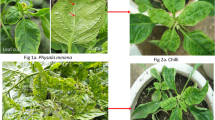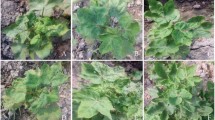Abstract
Severe symptoms of cotton leaf curl disease (CLCuD) are caused by the association of a single-stranded circular DNA satellite (betasatellite) with a helper begomovirus. In this study, we analyzed 40 leaf samples (primarily cotton with CLCuD symptoms and other plants growing close by) from four sites between New Delhi and the Pakistan/India border, using rolling-circle amplification (RCA) and PCR. In total, the complete sequences of 12 different helper viruses, eight alphasatellites, and one betasatellite from five different plant species were obtained. A recombinant helper virus molecule found in okra and a novel alphasatellite-related DNA from croton are also described. This is the first report of the presence of both DNA components (helper virus and betasatellite) associated with resistance-breaking CLCuD in India, and it highlights the need for further work to combat its damage and spread.





Similar content being viewed by others
References
Ahuja SL, Monga D, Dhayal LS (2007) Genetics of resistance to cotton leaf curl disease in Gossypium hirsutum L. under field conditions. J Hered 98:79–83
Akhtar KP, Jamil FF, Haq MA, Khan IA (2008) Comparison of resistance to cotton leaf curl disease (Multan/Burewala) in Gossypium hirsutum L. varieties and breeding lines. J Phytopathology 156:352–357
Ali M (1997) Breeding of cotton varieties for resistance to cotton leaf curl virus. Pakistan J Phytopathol 9:1–7
Amrao L, Amin I, Shahid MS, Briddon RW, Mansoor S (2010) Cotton leaf curl disease in resistant cotton is associated with a single begomovirus that lacks an intact transcriptional activator protein. Virus Res 152:153–163
Bao Y, Kapustin Y, Tatusova T (2008) Virus classification by pairwise sequence comparison (PASC). In: Mahy BWJ, Van Regenmortel MHV (eds) Encyclopedia of virology. Elsevier, Oxford, pp 342–348
Behjatnia SA, Dry IB, Rezaian MA (2007) Characterization and transient replication of tomato leaf curl virus defective DNAs. Arch Virol 152:1127–1138
Briddon RW, Markham PG (2000) Cotton leaf curl virus disease. Virus Res 71:151–159
Briddon RW, Mansoor S, Bedford ID, Pinner MS, Saunders K, Stanley J, Zafar Y, Malik KA, Markham PG (2001) Identification of DNA components required for induction of cotton leaf curl disease. Virology 285:234–243
Briddon RW, Stanley J (2006) Subviral agents associated with plant single-stranded DNA viruses. Virology 344:198–210
Chowda-Reddy RV, Dong W, Felton C, Ryman D, Ballard K, Fondong VN (2009) Characterization of the cassava geminivirus transcription activation protein putative nuclear localization signal. Virus Res 145:270–278
Das S, Roy A, Ghosh R, Paul S, Acharyya S, Ghosh SK (2008) Sequence variability and phylogenetic relationship of betasatellite isolates associated with yellow vein mosaic disease of mesta in India. Virus Genes 37:414–424
Doyle JJ, Doyle JL (1987) A rapid DNA isolation method for small quantities of fresh tissues. Phytochem Bull Bot Soc Am 19:11–15
Dry I, Krake L, Mullineaux P, Rezaian A (2000) Regulation of tomato leaf curl viral gene expression in host tissues. Mol Plant Microbe Interact 13:529–537
Fauquet CM, Bisaro DM, Briddon RW, Brown JK, Harrison BD, Rybicki EP, Stenger DC, Stanley J (2003) Revision of taxonomic criteria for species demarcation in the family Geminiviridae, and an updated list of begomovirus species. Arch Virol 148:405–421
Gopal P, Pravin Kumar P, Sinilal B, Jose J, Kasin Yadunandam A, Usha R (2007) Differential roles of C4 and betaC1 in mediating suppression of post-transcriptional gene silencing: evidence for transactivation by the C2 of Bhendi yellow vein mosaic virus, a monopartite begomovirus. Virus Res 123:9–18
Haible D, Kober S, Jeske H (2006) Rolling circle amplification revolutionizes diagnosis and genomics of geminiviruses. J Virol Methods 135:9–16
Hussain T, Mahmood T (1988) A note on leaf curl disease of cotton. Pakistan Cottons 32(4):248–251
Idris AM, Shahid MS, Briddon RW, Khan AJ, Zhu JK, Brown JK (2011) An unusual alphasatellite associated with monopartite begomoviruses attenuates symptoms and reduces betasatellite accumulation. J Gen Virol 92:706–717
Kirthi N, Priyadarshini CG, Sharma P, Maiya SP, Hemalatha V, Sivaraman P, Dhawan P, Rishi N, Savithri HS (2004) Genetic variability of begomoviruses associated with cotton leaf curl disease originating from India. Arch Virol 149:2047–2057
Kumar A, Kumar J, Khan JA (2010) Sequence characterization of cotton leaf curl virus from Rajasthan: phylogenetic relationship with other members of geminiviruses and detection of recombination. Virus Genes 40:282–289
Lefeuvre P, Martin DP, Hoareau M, Naze F, Delatte H, Thierry M, Varsani A, Becker N, Reynaud B, Lett JM (2007) Begomovirus ‘melting pot’ in the south-west Indian Ocean islands: molecular diversity and evolution through recombination. J Gen Virol 88:3458–3468
Liu Y, Robinson DJ, Harrison BD (1998) Defective forms of cotton leaf curl virus DNA-A that have different combinations of sequence deletion, duplication, inversion and rearrangement. J Gen Virol 79(Pt 6):1501–1508
Mansoor S, Khan SH, Bashir A, Saeed M, Zafar Y, Malik KA, Briddon R, Stanley J, Markham PG (1999) Identification of a novel circular single-stranded DNA associated with cotton leaf curl disease in Pakistan. Virology 259:190–199
Mansoor S, Briddon RW, Bull SE, Bedford ID, Bashir A, Hussain M, Saeed M, Zafar Y, Malik KA, Fauquet C, Markham PG (2003) Cotton leaf curl disease is associated with multiple monopartite begomoviruses supported by single DNA beta. Arch Virol 148:1969–1986
Mansoor S, Amin I, Hussain M, Zafar Y, Briddon RW (2006) Engineering novel traits in plants through RNA interference. Trends Plant Sci 11:559–565
Mansoor S, Zafar Y, Briddon RW (2006) Geminivirus disease complexes: the threat is spreading. Trends Plant Sci 11:209–212
Martin DP, Williamson C, Posada D (2005) RDP2: recombination detection and analysis from sequence alignments. Bioinformatics 21:260–262
Mubin M, Briddon RW, Mansoor S (2009) Complete nucleotide sequence of chili leaf curl virus and its associated satellites naturally infecting potato in Pakistan. Arch Virol 154:365–368
Mubin M, Briddon RW, Mansoor S (2009) Diverse and recombinant DNA betasatellites are associated with a begomovirus disease complex of Digera arvensis, a weed host. Virus Res 142:208–212
Mubin M, Amin I, Amrao L, Briddon RW, Mansoor S (2010) The hypersensitive response induced by the V2 protein of a monopartite begomovirus is countered by the C2 protein. Mol Plant Pathol 11:245–254
Nawaz-ul-Rehman MS, Fauquet CM (2009) Evolution of geminiviruses and their satellites. FEBS Lett 583:1825–1832
Paprotka T, Metzler V, Jeske H (2010) The first DNA 1-like alpha satellites in association with New World begomoviruses in natural infections. Virology 404:148–157
Posada D (2008) jModelTest: phylogenetic model averaging. Mol Biol Evol 25:1253–1256
Qazi J, Amin I, Mansoor S, Iqbal MJ, Briddon RW (2007) Contribution of the satellite encoded gene betaC1 to cotton leaf curl disease symptoms. Virus Res 128:135–139
Rojas MR, Hagen C, Lucas WJ, Gilbertson RL (2005) Exploiting chinks in the plant’s armor: evolution and emergence of geminiviruses. Annu Rev Phytopathol 43:361–394
Romay G, Chirinos D, Geraud-Pouey F, Desbiez C (2010) Association of an atypical alphasatellite with a bipartite New World begomovirus. Arch Virol 155:1843–1847
Saunders K, Bedford ID, Stanley J (2002) Adaptation from whitefly to leafhopper transmission of an autonomously replicating nanovirus-like DNA component associated with ageratum yellow vein disease. J Gen Virol 83:907–913
Saunders K, Bedford ID, Briddon RW, Markham PG, Wong SM, Stanley J (2000) A unique virus complex causes Ageratum yellow vein disease. Proc Natl Acad Sci USA 97:6890–6895
Skuzeski JM, Nichols LM, Gesteland RF, Atkins JF (1991) The signal for a leaky UAG stop codon in several plant viruses includes the two downstream codons. J Mol Biol 218:365–373
Sunter G, Bisaro DM (1992) Transactivation of geminivirus AR1 and BR1 gene expression by the viral AL2 gene product occurs at the level of transcription. Plant Cell 4:1321–1331
Swofford DL (1993) Paup: a computer-program for phylogenetic inference using maximum parsimony. J Gen Physiol 102:A9–A9
Tiendrebeogo F, Lefeuvre P, Hoareau M, Villemot J, Konate G, Traore AS, Barro N, Traore VS, Reynaud B, Traore O, Lett JM (2010) Molecular diversity of cotton leaf curl Gezira virus isolates and their satellite DNAs associated with okra leaf curl disease in Burkina Faso. Virol J 7:48
Trinks D, Rajeswaran R, Shivaprasad PV, Akbergenov R, Oakeley EJ, Veluthambi K, Hohn T, Pooggin MM (2005) Suppression of RNA silencing by a geminivirus nuclear protein, AC2, correlates with transactivation of host genes. J Virol 79:2517–2527
Wu P-J, Zhou X-P (2005) Interaction between a nanovirus-like component and the tobacco curly shoot virus/satellite complex. Acta Biochimica et Biophysica Sinica 37:25–31
Zhou X, Liu Y, Robinson DJ, Harrison BD (1998) Four DNA-A variants among Pakistani isolates of cotton leaf curl virus and their affinities to DNA-A of geminivirus isolates from okra. J Gen Virol 79(Pt 4):915–923
Acknowledgments
Many thanks to Dr. Dilip Mongia, CICR Sirsa, Prof. Narayan Rishi, CCS Agriculture University, Hissar, for assistance in the field, and to Mirco Boem, Laura Chiappetta, Slavica Matic, Marco Morroni, Arianna Friscina and Amit Bhardwaj for technical support and sound advice. This work was funded in part by Fondazione Cassamarca. Financial support of ICGEB is acknowledged.
Author information
Authors and Affiliations
Corresponding authors
Electronic supplementary material
Below is the link to the electronic supplementary material.
Rights and permissions
About this article
Cite this article
Zaffalon, V., Mukherjee, S.K., Reddy, V.S. et al. A survey of geminiviruses and associated satellite DNAs in the cotton-growing areas of northwestern India. Arch Virol 157, 483–495 (2012). https://doi.org/10.1007/s00705-011-1201-y
Received:
Accepted:
Published:
Issue Date:
DOI: https://doi.org/10.1007/s00705-011-1201-y




